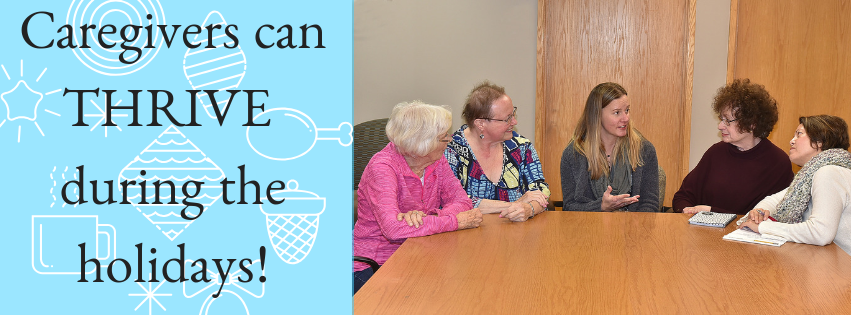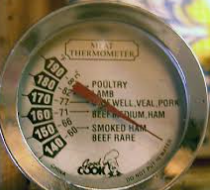https://www.youtube.com/watch?v=paVhRQtyixw&feature=youtu.be
Category Archives: Health Maintenance
Caregiving: Thrive Through the Holidays
 By Becky Allard, LSW
By Becky Allard, LSW
The upcoming holiday season can be a very stressful time for caregivers to balance the extra stressors of the holiday, as well as continuing to provide care to their loved one. It can be easy to get lost in the routine and traditions that we have held dear in the past. The holiday season may look different this year depending on the spot in the journey your loved one is currently at. No matter the journey, tips for thriving during the holiday season can apply to everyone!
TIPS
Let go of perfection! Holiday advertisements, holiday songs, and media reports all feed into showing the perfect holiday, what it “should” look like. Remember nobody can obtain perfection, and it will only add stress. Be present, and enjoy the moment that you are in! That is most likely what your loved one is doing, and so should you.
Review and revise your traditions! Ask yourself has this tradition become a chore, or do I find enjoyment with it? Give yourself permission to Simplify. It is OK to cut back or alter the activity to better fit your loved one’s abilities.
Stick to your normal routine, and be aware of your stress level. Follow the H.A.L.T.S. self-check strategy. Ask yourself, “Are you…” Hungry, Angry, Lonely, Tired, or Scared? Try to resolve those triggers to reduce your stress.
Prepare your guests with education about how the disease process has impacted your loved one. Tell them what they can expect from your loved one during the family gatherings. Offer guidance if needed on the best ways to interact so people aren’t surprised, and don’t shy away from your loved one.
Be mindful of family dynamics and emotions that go along with the holidays. Family members often fulfill a role within the family. That will most likely not change, so be mindful of your expectations of family members. Everyone is looking through a different lens on the situation, and each has unique feelings. Different perceptions will create different realities.
It is equally important to care for yourself during the holiday season! Think about the activities that fill your heart with happiness and joy. Do those activities to “Fill your tank” during the holiday season. Allow yourself to enjoy the holiday season too! Give yourself the gift of being present in the moment.
Humor at Work
The 7 Healthiest Habits to Add to Your Routine
(And None of Them is Running)
Make a list. Make your best guess, then check-out the link below for a great read and encouraging tips.
medium.com/thrive-global/the-7-healthiest-habits-to-add-to-your-routine-c3bf4fa4e5db
Benefits of Reading for Pleasure
It turns out that all those things are true.
It turns out that reading for pleasure has a wide range of extremely important benefits, benefits which we absolutely owe our young people. I’d argue that not to promote reading for pleasure and not to create a reading culture in school is a dereliction of duty towards our students. It will make their lives poorer.
Until 2015, I felt this in my heart but actual evidence was flimsy. There were many studies but some were very small or not replicated and it was hard to be able to say with any certainty what the results really showed. All that changed in 2015 when the UK’s Reading Agency published its Literature Review, a meta-study of hundreds of other studies over many years. “Reading for pleasure has a dramatic impact on life outcomes,” was the headline conclusion.
The research also showed that it wasn’t just the daily act of reading but the enjoyment of it that made the difference. Hence the phrase “reading for pleasure”. So, now we know: daily reading for pleasure positively affects mental health, self-esteem, vocabulary, general knowledge, socio-economic status, relationships, mood control, empathy, self-understanding and stress levels.
It was that last one – stress levels – that led me to invent the concept of “readaxation”. I define this as “Reading for pleasure deliberately to lower stress levels, thus increasing well-being and performance.”
Why might reading for pleasure reduce stress?
- Because readers believe it does. Ask any reader, “Do you think reading for pleasure would reduce stress?” and most say yes. Confirmation bias means we tend to see what we expect to see: if we expect to see stress reduction, we do.
- If we’re engaged in a book we can’t simultaneously be worrying – it gives negative thoughts a break.
- Reading for pleasure allows a state of “engagement”, offered by Martin Seligman and others as an importantly positive and transformative psychological state.
- It leads to increased self-worth, itself likely to reduce the stress of negative feelings.
- We can choose books to create a desired emotion. If our emotional state is one we don’t like, we can change that by reading a book that will make us feel another emotion.
- Reading gives us space away from the demands of other people. It gives us a break. This is especially important for introverts.
https://www.cambridge.org/elt/blog/2018/09/27/readaxation-reading-pleasure/
Encouragement on a Cold Day
Food Safety Charts
Food Safety Charts
With Thanksgiving right around the corner, it may be helpful to check the charts available on the links below.
The keys to basic food safety are cooking it to the right temperature and storing it properly.
Foods are properly cooked when they are heated for a long enough time and at a high enough temperature to kill the harmful bacteria that cause foodborne illness. Properly storing foods preserves food quality and prevents both spoilage and food poisoning. Consult the easy-to-read charts below to learn how to cook and store your food the right way.
- Safe Minimum Cooking Temperatures: Cook all food to these minimum internal temperatures as measured with a food thermometer for safety.
- Cold Food Storage Chart: Storage guidelines for home-refrigerated foods to keep them from spoiling or becoming dangerous to eat.
- Meat and Poultry Charts: Use these timetables to determine how long to cook meat & poultry products. Times are approximate.
- Food Safety in a Disaster or Emergency: How to keep food safe during and after an emergency, such as a flood, fire, national disaster, or the loss of power.
www.foodsafety.gov/food-safety-charts
Spend a Moment With a Moose
Enjoy a few moments with a moose to soothe and relax you!
Healthy Pets, Healthy People
Keeping Pets Healthy Keeps People Healthy Too!
Studies have shown that the bond between people and their pets can increase fitness, lower stress, and bring happiness to their owners. But there’s something else you should know.
Pets sometimes carry germs that can make people sick. The diseases people get from animals are known as zoonotic (zoe-oh-NOT-ic) diseases.
For more information on what to look for and prepare for:
www.cdc.gov/healthypets/index.html

Help on Your Water Intake
Latest ratings on best hydration trackers check:
www.healthline.com/health/hydration-top-iphone-android-apps-drinking-water

